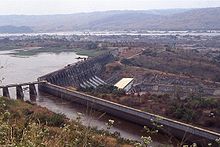Inga Dam
| Inga Dams | |
|---|---|

Inga I dam, with the feeding canal for Inga II in the foreground.
|
|
|
Location of Inga Dams in Democratic Republic of the Congo
|
|
| Country | Democratic Republic of the Congo |
| Coordinates | 5°31′09″S 13°37′19″E / 5.51917°S 13.62194°ECoordinates: 5°31′09″S 13°37′19″E / 5.51917°S 13.62194°E |
| Status | Operational |
| Construction began | Inga I: 1968 Inga II: |
| Opening date | Inga I: 1972 Inga II: 1982 |
| Power station | |
| Turbines | Inga I: 6 x 58.5 MW Inga II: 8 x 178 MW |
| Installed capacity | Inga I: 351 MW Inga II: 1,424 MW |
The Inga Dams are two hydroelectric dams connected to one of the largest waterfalls in the world, Inga Falls. They are located in the western Democratic Republic of the Congo and 140 miles southwest of Kinshasa. The Congo River drops 96 metres (315 ft).
The Belgian colonial government was considering starting what it called "The Inga Scheme" on the eve of decolonization in 1959. Inga I was completed in 1972, and Inga II in 1982.
The two hydroelectric dams, Inga I and Inga II, currently operate at a low output. Inga I has a total installed capacity of 351 MW and Inga II has 1424 MW. They were built under former president Mobutu Sese Seko as part of the Inga–Shaba project.
There are expansion plans to create a third Inga dam, Inga III. Projections indicate that once completed, Inga III would generate 4,500 MW of electricity. Inga III is the centerpiece of the Westcor partnership which envisions the interconnection of the electric grids of the Democratic Republic of the Congo (DRC), Namibia, Angola, Botswana, and South Africa. The World Bank, the African Development Bank, the European Investment Bank, bilateral donors, and the southern African power companies, have all expressed interest in pursuing the project which is estimated to cost 80 billion USD.
The Grand Inga Dam would generate 39,000 MW – and would significantly boost the energy available to the African continent at a cost of $80 billion. Connecting Inga to a continent-wide electricity grid for main population centers would cost $10 billion more (est. 2000), and would be the world's largest hydroelectric project. Critics contend the huge amounts of money required for the project would be better spent with smaller scale, localized energy projects that would better meet the needs of Africa's poor majority. A study from Oxford University supports this cautious approach by showing that the average cost overrun for 245 large dams in 65 countries across six continents is 96% in real terms.
...
Wikipedia

